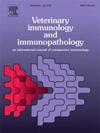作为韩国禽流感抗原库候选疫苗的 H7N9 疫苗的功效
IF 1.4
3区 农林科学
Q4 IMMUNOLOGY
引用次数: 0
摘要
2013 年在中国首次发现的甲型禽流感病毒(H7N9)是一种人畜共患病毒,尽管由于采取了控制措施,人类感染病例有所减少,但该病毒仍在鸟类种群中持续存在。因此,本研究旨在开发一种疫苗作为预防策略,以应对 H7N9 可能进入韩国的情况。利用 2018-2019 年 H7N9 的血凝素和神经氨酸酶共识序列,开发了重组 H7N9 疫苗 rgAPQAH7N9,并评估了其对特定无病原体鸡的保护效力。rgAPQAH7N9 疫苗在鸡蛋中增殖,并表现出高免疫原性,血凝抑制滴度为 9.3 log2。此外,疫苗还能提供完全的保护,接种疫苗的鸡不会出现临床症状或病毒脱落。此外,当对 rgAPQAH7N9 疫苗进行加强免疫时,所产生的免疫力是持久的,血凝抑制滴度在 6 个月后仍能保持在 7 log2。因此,rgAPQAH7N9 疫苗病毒可被视为禽流感抗原库中的潜在候选病毒,以确保为家禽的紧急疫苗接种做好准备。本文章由计算机程序翻译,如有差异,请以英文原文为准。
Efficacy of the H7N9 vaccine as a candidate for the Korean avian influenza antigen bank
The avian influenza A virus (H7N9), first detected in China in 2013, is a zoonotic virus that remains persistent in bird populations despite a decline in human cases owing to control measures. Therefore, this study aimed to develop a vaccine as one preventive strategy in anticipation of the potential entry of H7N9 into Korea. Using the hemagglutinin and neuraminidase consensus sequences of H7N9 from 2018–2019, a recombinant H7N9 vaccine, rgAPQAH7N9, was developed, and its protective efficacy in specific pathogen-free chickens was evaluated. The rgAPQAH7N9 vaccine exhibited proliferation in eggs and demonstrated high immunogenicity, with a hemagglutination inhibition titer of 9.3 log2. Furthermore, the vaccine provided complete protection, as vaccinated chickens did not exhibit clinical signs or viral shedding. Moreover, when the rgAPQAH7N9 vaccine was boosted, the resulting immunity was long-lasting, with hemagglutination inhibition titers > 7 log2 persisting after 6 months. Therefore, the rgAPQAH7N9 vaccine virus may be considered a potential candidate for inclusion in the avian influenza antigen bank to ensure preparedness for emergency vaccination in poultry.
求助全文
通过发布文献求助,成功后即可免费获取论文全文。
去求助
来源期刊
CiteScore
3.40
自引率
5.60%
发文量
79
审稿时长
70 days
期刊介绍:
The journal reports basic, comparative and clinical immunology as they pertain to the animal species designated here: livestock, poultry, and fish species that are major food animals and companion animals such as cats, dogs, horses and camels, and wildlife species that act as reservoirs for food, companion or human infectious diseases, or as models for human disease.
Rodent models of infectious diseases that are of importance in the animal species indicated above,when the disease requires a level of containment that is not readily available for larger animal experimentation (ABSL3), will be considered. Papers on rabbits, lizards, guinea pigs, badgers, armadillos, elephants, antelope, and buffalo will be reviewed if the research advances our fundamental understanding of immunology, or if they act as a reservoir of infectious disease for the primary animal species designated above, or for humans. Manuscripts employing other species will be reviewed if justified as fitting into the categories above.
The following topics are appropriate: biology of cells and mechanisms of the immune system, immunochemistry, immunodeficiencies, immunodiagnosis, immunogenetics, immunopathology, immunology of infectious disease and tumors, immunoprophylaxis including vaccine development and delivery, immunological aspects of pregnancy including passive immunity, autoimmuity, neuroimmunology, and transplanatation immunology. Manuscripts that describe new genes and development of tools such as monoclonal antibodies are also of interest when part of a larger biological study. Studies employing extracts or constituents (plant extracts, feed additives or microbiome) must be sufficiently defined to be reproduced in other laboratories and also provide evidence for possible mechanisms and not simply show an effect on the immune system.

 求助内容:
求助内容: 应助结果提醒方式:
应助结果提醒方式:


